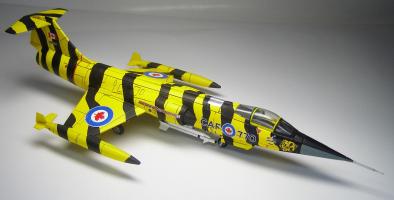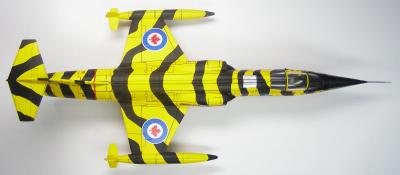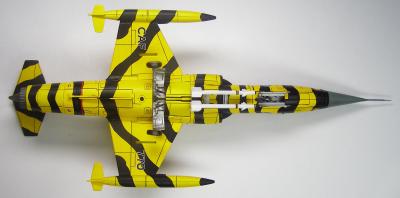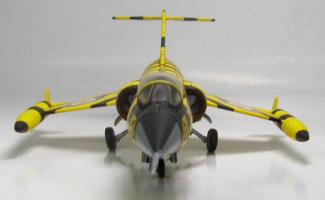Hobby Master Archive
Air Power Jets 1/72
F-104
Canadian Armed Forces, CF-104G, 439 Sqn., "Tiger Meet" 1972
Hobby Master 1/72 Air Power Series HA1005 Canadian Armed Forces CF-104G, 439 Sqn., “Tiger Meet” 1972
THESE ARE PRE-PRODUCTION PICTURES NOT THE RETAIL VERSION
Die-cast metal. Superb detailing in 1/72 scale. Pre-painted with pad applied markings. Fully assembled. Display stand included. Option to display model with wheels up or down. Minimum use of plastic. Very collectable The modern-day 439 squadron “The Sabre-Toothed Tigers” were based in Marville France in 1955 and received the CF-104 in March 1964, in 1967 moved to Lahr Germany and finally in 1970 to Baden-Soellingen, Germany until 1984. The RCAF CF-104 was primarily used for low-level strike and reconnaissance with nuclear capabilities. The 439 represented the RCAF at the 1972 NATO Tiger Meet with aircraft 104770 serving as their Squadron Tiger Bird. The Meet was hosted by France’s EC 1/12 in Cambrai. The same aircraft was used in 1973 and 75’ with different schemes.
Background on the F-104G The F-104G was known as the Super Starfighter, with the G standing for Germany, because they were among the first foreign orders for the Lockheed plane and they placed the largest order. Depending on the source there were between 1,122 and 1,700 G models built under license by 4 European companies, Canadair and Lockheed. The G was a multi-role all weather single seat fighter-bomber with a new upward firing ejection seat, a strengthened fuselage and wings, increased internal fuel capacity, new improved full length flaps added to the wings leading edge for better combat maneuvering, a larger vertical fin, a new radar system with air-air and air-ground modes, inertial navigation that made the F-104G the first production fighter to receive this new equipment, new infrared sight, an additional hard-point under each wing, improved weapons capability now was 4,000 lbs and beefed up landing gear and larger wheels to carry all the added weight of the improvements. The larger gear and wheels made it necessary to create a bulge in the fuselage to accommodate them. The G even received a new engine, though it didn’t deliver any more power it was a much more reliable engine. The G was considered the best version of the F-104. The U.S. only accepted 296 Starfighters before it was considered to be less than satisfactory. With modifications the F-104 was sold to many NATO countries, using what was to become known as “Deal of the Century”. This brought about an extremely large income for Lockheed and caused a huge political controversy in Europe. The general feeling was that the countries bought the F-104 only after they were brow beaten by U.S. political powers and a considerable amount of funds were given as bribes to the people in European governments responsible for aircraft procurement. There was a huge outcry in Germany and the minister of defence was forced to resign. Prince Bernhard of the Netherlands was also linked to the scandal and later admitted taking over 1 million dollars US. Later in the 1970s it was revealed that Lockheed had in deed been involved in political bribery in an effort to save the company that was going through hard times and close to bankruptcy. Furthermore, after many F-104 crashes and deaths the general consensus was the Starfighter was an unsafe plane. What might have been the defining answer to the question of “was the Starfighter a safe plane” Oberleutnant von Hassel, the son of the new German minister of defence was killed in an F-104G. The last Starfighter flew in military service until 2004 when Italy finally retired them.
Specifications for the F-104G: Engine: One General Electric J79-GE-11A turbojet, 10,000 lb.s.t. dry and 15,600 lb.s.t. with afterburning.
Performance: Maximum speed 1146 mph at 50,000 feet, 1328 mph at 35,000 feet. Stalling speed 216 mph. Initial climb rate 48,000 feet per minute. Service ceiling 50,000 feet, and absolute ceiling 90,000 feet. Normal range 1080 miles. Maximum range with four drop-tanks was 1630 miles.
Fuel: Internal fuel capacity was 897 US gallons, and maximum fuel capacity with two wingtip tanks and two under-wing tanks was 1784 US gallons.
Dimensions: Wingspan 21 feet 9 inches, length 54 feet 8 inches, height 13 feet 6 inches, wing area 196.1 square feet.
Weights: 13,996 pounds empty, 20,640 pounds combat, 29,038 pounds maximum takeoff.
Armament: One 20-mm M61A1 cannon with 725 rounds in the fuselage, plus up to four AIM-9B Sidewinder infrared homing air-to-air missiles. Up to 4000 pounds of external ordnance (bombs, rockets, napalm, drop tanks) could be carried on under-wing and under-fuselage hard-points.
| Added to archive | 2015-11-19 |
| Last modified | 2015-11-19 |






